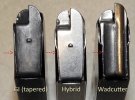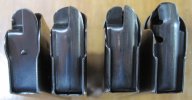462
California's Central Coast Amid The Insanity
I won't go into all the details -- they are in the What Did You Shoot Today thread if anyone is interested -- but my .45 ACP Randall 1911 has occasional feeding/chambering hiccups with the Lee 452-230 TC. The Lyman 452374 has always feed/chambered without fault.
Forum member Pistolero (Bill) once explained the advantages and disadvantages of each of the three designs of 1911 magazine feed lips. At the time I was shooting Lyman's 452374 ball clone and 452460 SWC (it hiccuped, too), so following his advise I ordered some Check-Mate hybrid magazines. (He also advised using a Lee taper crimp die and a crimp of .467" or .468" instead of the accepted .470", but that's another story.). The new magazines (and the new crimp dimension) improved the 452460 feeding/chambering, but not totally.
Fast forward to a few months ago: Thanks to an always very generous Ian, I have a Lee 452-230 TC mould. I like the bullet's design and have had a lot of fun developing accuracy loads with no less than five different powders. However, there is the occasional hiccup, and it happens with both the new Check-Mate hybrid magazines or the original Randalls. For several reasons, I'm pretty much convinced there is another cause to the problem, but that's not what this thread is about.
What it is about is, I would like someone more knowledgeable than I am to tell me what kind of feed lips the original Randall magazines have.
First off: Below is a self-explanatory and stolen Internet picture of the three different designs.

Here is a side view picture of my magazines. Check-Mate hybrid on the left, the others are the original Randalls. Notice that the Randalls have three different designs.

Here is a top view. Again, the Check-Mate is on the left. Notice, again, the differences between the Randalls.

So, can anyone tell me what designs the Randalls are? (I suspect the second and the fourth ones are tapered G. I. lips, but the cutout areas make me suspect otherwise.). The gun was made in the early part of '85, if that means anything.
Thank you.
Michael
Forum member Pistolero (Bill) once explained the advantages and disadvantages of each of the three designs of 1911 magazine feed lips. At the time I was shooting Lyman's 452374 ball clone and 452460 SWC (it hiccuped, too), so following his advise I ordered some Check-Mate hybrid magazines. (He also advised using a Lee taper crimp die and a crimp of .467" or .468" instead of the accepted .470", but that's another story.). The new magazines (and the new crimp dimension) improved the 452460 feeding/chambering, but not totally.
Fast forward to a few months ago: Thanks to an always very generous Ian, I have a Lee 452-230 TC mould. I like the bullet's design and have had a lot of fun developing accuracy loads with no less than five different powders. However, there is the occasional hiccup, and it happens with both the new Check-Mate hybrid magazines or the original Randalls. For several reasons, I'm pretty much convinced there is another cause to the problem, but that's not what this thread is about.
What it is about is, I would like someone more knowledgeable than I am to tell me what kind of feed lips the original Randall magazines have.
First off: Below is a self-explanatory and stolen Internet picture of the three different designs.

Here is a side view picture of my magazines. Check-Mate hybrid on the left, the others are the original Randalls. Notice that the Randalls have three different designs.

Here is a top view. Again, the Check-Mate is on the left. Notice, again, the differences between the Randalls.

So, can anyone tell me what designs the Randalls are? (I suspect the second and the fourth ones are tapered G. I. lips, but the cutout areas make me suspect otherwise.). The gun was made in the early part of '85, if that means anything.
Thank you.
Michael
